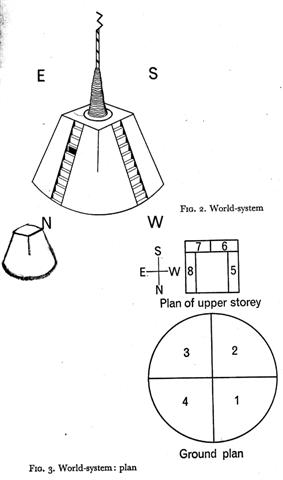There was an ancient mythic theme describing how fire originally was aquired, e.g. the version of OgotemmÍli: ... All was now ready for departure except that there was no fire in the smithy. The ancestor slipped into the workshop of the great Nummo, who are Heaven's smiths, and stole a piece of the sun in the form of live embers and white-hot iron. He seized it by means of a 'robber's stick' the crook of which ended in a slit, open like a mouth. He dropped some of the embers, came back to pick them up, and fled towards the granary; but his agitation was such that he could no longer find the entrances.
He made the round of it several times before he found the steps and climbed onto the flat roof, where he hid the stolen goods in one of the skins of the bellows, exclaiming: 'Gouyo!', which is to say. 'Stolen!'. The word is still part of the language, and means 'granary'. It is a reminder that without the fire of the smithy and the iron of hoes there would be no crops to store ... In spring these original events were repeated yearly. Sun (the Smith) returned with his 'fire' (light) and then Mother Nature brought forth a new generation. It might be no coincidence that we cannot see the face of this Egyptian smith (because you should not look the Sun King in his face):
(Picture from Richard H. Wilkinson, Hieroglyfernas všrld.) At bottom left is the horizon (achet) with Sun (the 'Face') rising between a pair of hills.
In rongorongo times 22h was where the Lucky King star (Sadalmelik, α Aquairii) was rising together with the Sun:
According to the G tablet the end of side a corresponds to glyph 230 (counted from Gb8-30) and the pair Cb6-9--10 is the first in my table with 12 such pairs. But the Arabs had their 23rd manzil Al Sa'd al Ahbiyah defined not by the star Sadalmelik but by the star Sadachbia (the Luck of that which is Hidden, γ Aquarii):
And among the Hindus the star Sadachbia (probably the same name as Shatabisha) was also of great importance:
Perhaps the reason was an ancient tradition which had February 23-24 connected with the leap day: ... The ordinary year in the previous Roman calendar consisted of 12 months, for a total of 355 days. In addition, a 27-day intercalary month, the Mensis Intercalaris, was sometimes inserted between February and March. This intercalary month was formed by inserting 22 days after the first 23 or 24 days of February; the last five days of February, which counted down toward the start of March, became the last five days of Intercalaris. The net effect was to add 22 or 23 days to the year, forming an intercalary year of 377 or 378 days ... ... The leap day was introduced as part of the Julian reform. The day following the Terminalia (February 23) was doubled, forming the 'bis sextum - literally 'double sixth', since February 24 was 'the sixth day before the Kalends of March' using Roman inclusive counting (March 1 was the 'first day'). Although exceptions exist, the first day of the bis sextum (February 24) was usually regarded as the intercalated or 'bissextile' day since the third century. February 29 came to be regarded as the leap day when the Roman system of numbering days was replaced by sequential numbering in the late Middle Ages ... Furthermore, in rongorongo times the star Castor (α Gemini) culminated at midnight in February 23. | ||||||||||||||||||||||||||||||||||||||||||||||||||||||||||||||||||||||||||||||||||||||||||||||||||||||||||||||||||







